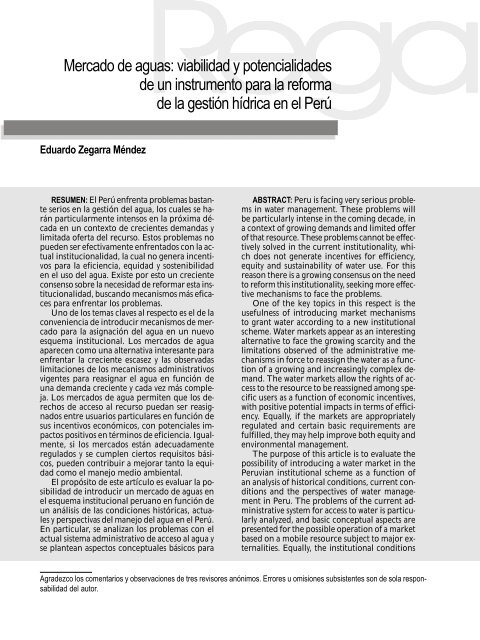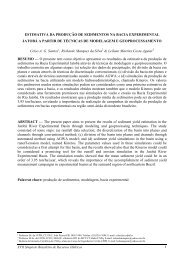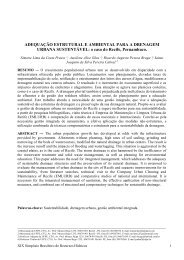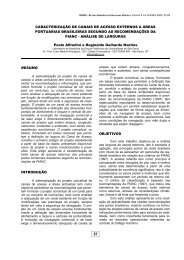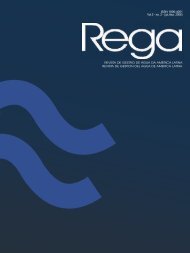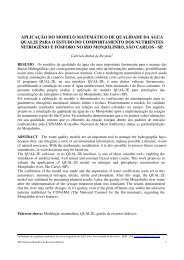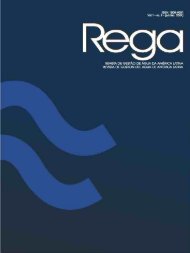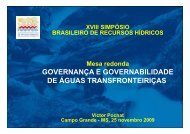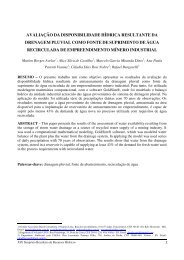Rega-17 (sem issn) - Cepal
Rega-17 (sem issn) - Cepal
Rega-17 (sem issn) - Cepal
- No tags were found...
Create successful ePaper yourself
Turn your PDF publications into a flip-book with our unique Google optimized e-Paper software.
Mercado de aguas: viabilidad y potencialidadesde un instrumento para la reformade la gestión hídrica en el PerúEduardo Zegarra MéndezRESUMEN: El Perú enfrenta problemas bastanteserios en la gestión del agua, los cuales se haránparticularmente intensos en la próxima décadaen un contexto de crecientes demandas ylimitada oferta del recurso. Estos problemas nopueden ser efectivamente enfrentados con la actualinstitucionalidad, la cual no genera incentivospara la eficiencia, equidad y sostenibilidaden el uso del agua. Existe por esto un crecienteconsenso sobre la necesidad de reformar esta institucionalidad,buscando mecanismos más eficacespara enfrentar los problemas.Uno de los temas claves al respecto es el de laconveniencia de introducir mecanismos de mercadopara la asignación del agua en un nuevoesquema institucional. Los mercados de aguaaparecen como una alternativa interesante paraenfrentar la creciente escasez y las observadaslimitaciones de los mecanismos administrativosvigentes para reasignar el agua en función deuna demanda creciente y cada vez más compleja.Los mercados de agua permiten que los derechosde acceso al recurso puedan ser reasignadosentre usuarios particulares en función desus incentivos económicos, con potenciales impactospositivos en términos de eficiencia. Igualmente,si los mercados están adecuadamenteregulados y se cumplen ciertos requisitos básicos,pueden contribuir a mejorar tanto la equidadcomo el manejo medio ambiental.El propósito de este artículo es evaluar la posibilidadde introducir un mercado de aguas enel esquema institucional peruano en función deun análisis de las condiciones históricas, actualesy perspectivas del manejo del agua en el Perú.En particular, se analizan los problemas con elactual sistema administrativo de acceso al agua yse plantean aspectos conceptuales básicos paraABSTRACT: Peru is facing very serious problemsin water management. These problems willbe particularly intense in the coming decade, ina context of growing demands and limited offerof that resource. These problems cannot be effectivelysolved in the current institutionality, whichdoes not generate incentives for efficiency,equity and sustainability of water use. For thisreason there is a growing consensus on the needto reform this institutionality, seeking more effectivemechanisms to face the problems.One of the key topics in this respect is theusefulness of introducing market mechanismsto grant water according to a new institutionalscheme. Water markets appear as an interestingalternative to face the growing scarcity and thelimitations observed of the administrative mechanismsin force to reassign the water as a functionof a growing and increasingly complex demand.The water markets allow the rights of accessto the resource to be reassigned among specificusers as a function of economic incentives,with positive potential impacts in terms of efficiency.Equally, if the markets are appropriatelyregulated and certain basic requirements arefulfilled, they may help improve both equity andenvironmental management.The purpose of this article is to evaluate thepossibility of introducing a water market in thePeruvian institutional scheme as a function ofan analysis of historical conditions, current conditionsand the perspectives of water managementin Peru. The problems of the current administrativesystem for access to water is particularlyanalyzed, and basic conceptual aspects arepresented for the possible operation of a marketbased on a mobile resource subject to major externalities.Equally, the institutional conditionsAgradezco los comentarios y observaciones de tres revisores anónimos. Errores u omisiones subsistentes son de sola responsabilidaddel autor.


